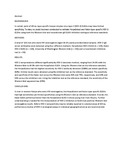| dc.contributor.author | Smith, JS | |
| dc.contributor.author | Bailey, RC | |
| dc.contributor.author | Westreich, DJ | |
| dc.contributor.author | Maclean, I | |
| dc.contributor.author | Agot, K | |
| dc.contributor.author | Ndinya-Achola JO. | |
| dc.contributor.author | Hogrefe, W | |
| dc.contributor.author | Morrow, RA | |
| dc.contributor.author | Moses, S | |
| dc.date.accessioned | 2013-04-24T10:32:58Z | |
| dc.date.available | 2013-04-24T10:32:58Z | |
| dc.date.issued | 2009 | |
| dc.identifier.citation | Sex Transm Infect. 2009 Apr;85(2):92-6 | en |
| dc.identifier.uri | http://www.ncbi.nlm.nih.gov/pubmed/18955387 | |
| dc.identifier.uri | http://erepository.uonbi.ac.ke:8080/xmlui/handle/123456789/16569 | |
| dc.description.abstract | BACKGROUND:
In certain parts of Africa, type-specific herpes simplex virus type 2 (HSV-2) ELISAs may have limited specificity. To date, no study has been conducted to validate HerpeSelect and Kalon type-specific HSV-2 ELISAs using both the Western blot and recombinant gG ELISA inhibition testing as reference standards.
METHODS:
A total of 120 men who were HIV seronegative (aged 18-24 years) provided blood samples. HSV-2 IgG serum antibodies were detected using four different methods: HerpeSelect HSV-2 ELISA (n = 120), Kalon HSV-2 ELISA (n = 120), University of Washington Western blot (n = 101) and a recombinant inhibition test (n = 93).
RESULTS:
HSV-2 seroprevalence differed significantly by HSV-2 detection method, ranging from 24.8% with the Western blot to 69.8% with the HerpeSelect ELISA. Using the Western blot as the reference standard, the HerpesSelect had the highest sensitivity for HSV-2 antibody detection (100%) yet lowest specificity (40%). Similar results were obtained using the inhibition test as the reference standard. The sensitivity and specificity of the Kalon test versus the Western blot were 92% and 79%, respectively, and 80% and 82% versus the inhibition test. Using the inhibition test as the reference standard, the sensitivity of the Western blot appeared low (49%).
CONCLUSIONS:
In men in western Kenya who were HIV seronegative, the HerpeSelect and Kalon type-specific ELISAs had high sensitivities yet limited specificities using the Western blot as reference standard. Overall, the Kalon ELISA performed better than the HerpeSelect ELISA in these young men from Kisumu. Further understanding is needed for the interpretation of HSV-2 inhibition or ELISA test positive/ Western blot seronegative results. Before HSV-2 seropositivity may be reliably reported in selected areas of Africa, performance studies of HSV-2 serological assays in individual geographical areas are recommended | en |
| dc.language.iso | en | en |
| dc.title | Herpes simplex virus type 2 antibody detection performance in Kisumu, Kenya, using the Herpeselect ELISA, Kalon ELISA, Western blot and inhibition testing | en |
| dc.type | Article | en |
| local.publisher | University of North Carolina, Chapel Hill, North Carolina | en |
| local.publisher | University of Illinois at Chicago, Illinois | en |
| local.publisher | University of Manitoba, Manitoba, Canada | en |
| local.publisher | University of Nairobi, Nairobi, Kenya | en |


